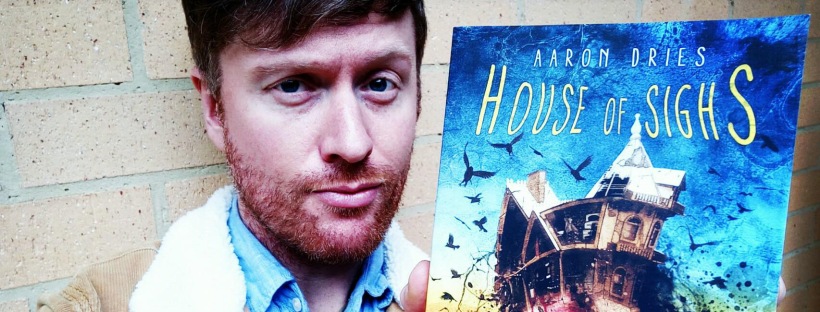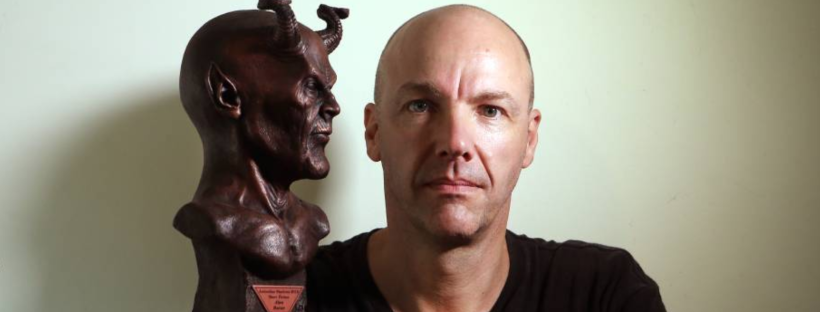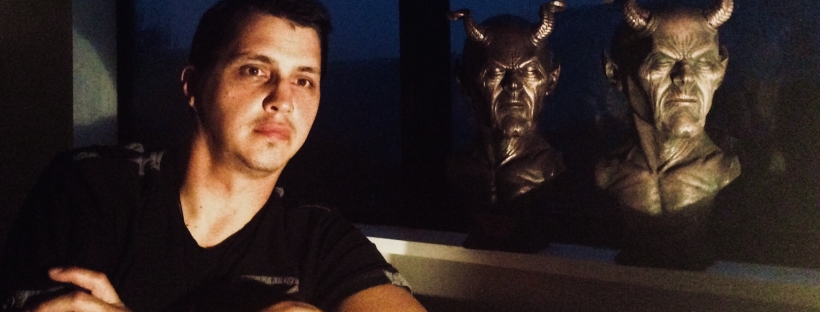Aaron Dries may well be Australia’s most dapper man of horror. An artist and writer, his oh-so Australian novels, A Place For Sinners, The Fallen Boys, and House of Sighs, made his name in the US indie horror scene. Now he’s bringing the love back home. We caught up with Aaron to get the skinny on his latest release and why it’s his most personal yet…
Your novel HOUSE OF SIGHS has just been re-released by Crystal Lake Publishing. Can you tell us a bit about the story (without spoilers, of course)?
House of Sighs kicks off when a local Hunter Valley bus driver named Liz Frost, pulls a gun from her mouth and decides to live with her loneliness for one more day. She dresses, combs her hair, and goes to work on mind-numb autopilot. Nine souls board her route, nine souls that Liz then drags back to her home against their will. She wants to build a new family for herself from these passengers, men and women who are willing to kill to avoid becoming her kin. The bus leaves a trail of carnage in its wake as it rockets towards a house that has held its secrets for far too long, a place where crows now gather, ready to feed on whatever’s left behind.
The book was originally published in 2012, and returns in a brand new edition that also includes a never before published sequel, a novella titled The Sound of His Bones Breaking.
The sequel tells the story of Aiden and Danny. They’re downing beers in an open bar overlooking a busy Lismore road, their legs brushing together, which is about as far as they let their public displays of affection go in that part of Australia. The warm breeze and pounding music—they don’t know it then, but it’s their last truly happy memory. Everything changes when a taxi pulls up and its drunken driver stumbles out, starting a street brawl that leaves Danny broken and bleeding on the ground. In an attempt to give his lover the space he needs to heal, Aiden accepts an employment opportunity in Thailand, and the two men set off overseas, their fates sealed air-tight within the confines of the airplane. But in the claustrophobic hush of their tiny Bangkok apartment, and while Aiden goes off to work, instead of mending, Danny’s old scars begin to sing. The lonely walks… The woman cooking bones in a vat of broth, whispering at him to eat the parts that hurt… The flies nobody but Danny can hear… And his maddening desire to trace his heritage of hurt back to ground zero, and there find someone to blame.
Is there some interesting backstory to the idea for Sighs?
While going to university in Newcastle, I worked as a pizza boy in the Hunter Valley, which is where House of Sighs is set. I had this one family on my route that I used to deliver to on a weekly basis – a mother and her two, cute-as-a-button kids. They always ordered the same thing: vegetarian pizzas. Like, this was a treat, but mum was keeping things health conscious(ish), you know? Or at least, that’s what I always thought. I used to see them all the time. They knew me by name. But the orders stopped coming out of the blue, and I saw on the news that they all were dead. Mum murdered the kids and then suicided. This shocked me deeply. My interactions with them were purely superficial, but it illustrated to me how little we know about what goes on behind closed doors. The questions in my head (what made her do it? etc) led to a short film called Placebo that I wrote and directed as my major work in my final year of uni. That film won a number of awards and opened a lot of doors for me. But still, the insidious questions wouldn’t let me be. That search evolved into the novel, House of Sighs, which I entered into the International Fresh Blood Contest run by Leisure Books/ChiZine Publications/and Rue Morgue Magazine – a Survivor-type elimination competition in which the winner was awarded a publishing contract. Of the many, many people who subbed manuscripts, Don D’Auria at Leisure picked me out of the slush and dropped me in the top ten. Seven months later, after public voting and some pretty damn amazing critique from my peers, I actually won. The book was published in limited hardcover by ChiZine and the paperback rights eventually landed in Don’s new line at Samhain Horror. The book was out of print for a while, but it’s back now thanks to the great folks at Crystal Lake Publishing.
Incidentally, I went home recently in the Hunter to visit my family and to swing by the graves of my grandparents. Remember the woman who murdered her kids and then killed herself? Well, it turns out she’s buried right next to my grandfather. I didn’t know what to make of this. I still don’t. But it weirdly chills me to the bone.
What are you working on at the moment?
I’ve always got something on the cooker. I’ve been working on a big supernatural book for a few years now called Lady Guillotine. I’ve got some short stories in various stages of completion, some of which already have homes and others I’ll shop around. Mark Allan Gunnells and I have long-term ambitions to collaborate again (our first work was called Where the Dead Go to Die, and the reception was pretty damn amazing, so we’re keen to give things another go), and who knows, that might happen later this year. And finally, I’ve started work on a story set right here in Canberra, the city I now call home; it’s a thriller that’s exponentially growing into a novella. So, we’ll see. It ain’t done ’til it’s done.
Outside of that, I’ve been working on a couple of screenplays with a few great writers – but I can’t say any more than that right now. And as a commissioned artist, I’m forever busy washing paint from my hair. That keeps me out of mischief when I’m not writing in my lunchbreak at the day-job.
What sparked the idea for a continuation of House of Sighs?
As for how Bones and Sighs are tied – aha! I cannot say, for fear of spoilers. Let’s see what people make of the connection (also, keep an eye out keen reader, as Bones ties together all of my Australian set novels and novellas thus far in subtle little ways). I’ve been sitting on an idea for a sequel for years, really since Sighs was published, but I just couldn’t connect the dots. That was until about two Christmases ago. I was having catch-up beers with a mate in Ballina up the coast. We watched this drunk taxi driver pull up at the curb and almost start a street-brawl. As soon as it happened, these disparate notions that had been floating around in my head came together. It was an almost audible click – it felt bloody great.
This story means a lot to me because I guess I’m laying down my armour a bit. Sure, there’s a lot of me in everything I write, but there’s a bit more in this one – my first fully LGBTIQ themed piece. And I’m not talking a subsidiary theme this time, as was the case in Sighs, or an exploration of that theme via metaphor, which Mark and I did in Where the Dead Go to Die. This is a love story about two gay men. There’s been a big push of late to bring the diversity that enriches our lives into our fiction, and thus elevate the genre in the process. I guess I’ve been inspired to be brave enough to do so by others. The people in the book aren’t me – I want to make that clear. But it cuts close to the bone, even if those bones are slowly breaking.
You’ve spent much of your career writing Australian stories for American markets. Can you tell us a bit about that?
That’s true. Nearly all of my stuff has been published abroad, yet I’ve written almost exclusively about Australian places and characters. Initially, I thought this would hold me back, that the regionality would hold me back from getting published. Wrong. From my very first review for Sighs way back when, people commented on how fascinating and sometimes frightening a place Australia is for international readers. A ‘sense of place’ is vital to successful horror fiction – so why not keep it ‘exotic’, even if that exoticism, to us, looks a bit like our own backyards – with or without the kangaroos, snakes, and spiders.
The horror genre has always embraced location and regional settings, when it’s done well. For me, setting and sense of time is just as important as the world-building you’ll find in fantasy or sci-fi. Us horror fans have always lapped that stuff up. It’s the TEXAS Chain Saw Massacre, after all. And What We Do in the Shadows works so well because of how candidly it opens its Kiwi veins for us to drink. Under the Shadow, one of the finest horror films of the last ten years, works so damn well because of its utterly genuine setting in 1980s Tehran. Picnic at Hanging Rock, both the film and the novel, linger in your mind because of the eerie, hungry worlds in which they exist. Hell, Stephen King made a name for himself (among other reasons) for keeping the majority of his work in Maine, a place he both knows and loves. They say ‘write what you know’. I ascribe to that philosophy, too. If you write real, all worlds—no matter how small or big they may be—will feel real.
Whenever I meet readers, many of whom are from overseas, the first thing they say to me is how much they want to go to Australia after reading my books. Even though they’re scared to. I guess this is me doing my part for the tourism industry, right? Only, I’m doing it my way.
Apologies to Baz Luhrmann.
And finally, tell us something about you that no one else knows…
Hmm. I’m terribly prone to what my mother calls ‘The Boy Look’. Something could be right in front of me, be it a stapler, my phone charger, the block of butter in the refrigerator … and still, damn it, I just won’t see it. It’s as though for me to actually find something, it’s got to lurk in the corner of my peripheral vision. Like I’ve got invisible gremlins doing a number on me, or something.
But in all seriousness, how about I tell you a real secret? Something juicy. The worst thing..
(Inner monologue: Are you sure you want to do that, Aaron?).
Okay. Maybe I won’t. Because if you knew about that, I’d probably have to kill you.
If you want to learn more about Aaron and his shady past, check out www.aarondries.com. And while you’re at it, grab yourself a copy of House of Sighs/The Sound of His Bones Breaking and The Fallen Boys.





